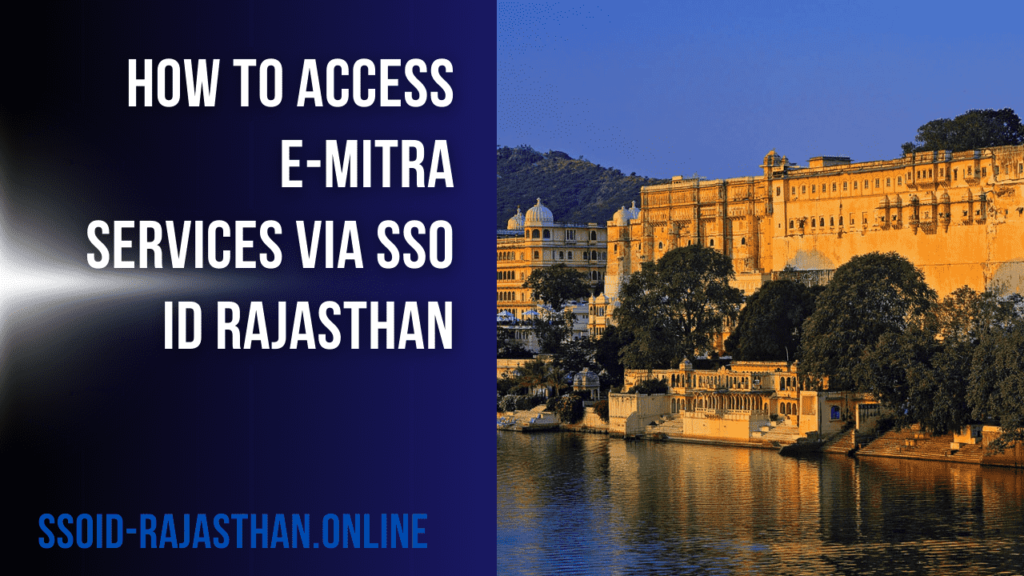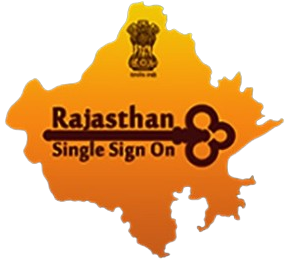Accessing e Mitra Services via SSO ID Rajasthan represents a pivotal advancement in the state’s digital governance, integrating the comprehensive e-Mitra platform with a unified Single Sign-On system. This innovation has revolutionized citizen-government interactions, offering enhanced convenience and efficiency. Our exploration will cover the impact of this integration on public service delivery, examining its benefits, challenges, and implications for digital literacy and administrative efficiency. We’ll analyze how this synergy is reshaping government services in Rajasthan, from improving user experiences to bolstering data security.

This article will delve into the technical aspects, policy implications, and future potential of the integrated system. We’ll discuss how it bridges the urban-rural divide, promotes transparency, and enables data-driven governance. By examining the balance between user-friendliness and security, as well as efficiency and inclusivity, we aim to provide a comprehensive overview of this pioneering e-governance initiative and its significance for Rajasthan’s digital future.
Understanding e-Mitra and SSO ID Rajasthan
Before diving into the specifics, it’s crucial to understand what e-Mitra and SSO ID Rajasthan entail. e-Mitra is an ambitious e-governance initiative by the Rajasthan government, aimed at providing various government services to citizens through a single window system. SSO ID Rajasthan, on the other hand, is a unified digital identity system that allows users to access multiple government services with a single set of login credentials.
The integration of these two systems has created a powerful platform for service delivery, significantly enhancing the accessibility and efficiency of government services. However, this integration also brings its own set of challenges and considerations.
Benefits of Accessing e Mitra Services via SSO ID Rajasthan
Streamlined Access to Multiple Services
One of the primary advantages of using SSO ID Rajasthan for e-Mitra services is the streamlined access it provides. Citizens no longer need to remember multiple usernames and passwords for different services. With a single login, they can access a wide range of e-Mitra services, from paying utility bills to applying for various certificates.
Enhanced User Experience
The integration of SSO ID with e-Mitra significantly improves the user experience. The unified interface reduces confusion and makes navigation between different services seamless. This improved usability is particularly beneficial for citizens who may not be tech-savvy, making government services more accessible to a broader demographic.
Improved Security and Data Management
By centralizing user authentication through SSO ID, the system enhances security measures. It reduces the risk of password-related vulnerabilities and allows for more robust security protocols. Additionally, it simplifies data management for both users and the government, as personal information and documents can be stored securely in one place.
Time and Cost Efficiency
The combined system saves time for both citizens and government officials. Users can quickly access multiple services without repeatedly entering their details, while government departments can process requests more efficiently due to the centralized data. This efficiency translates to cost savings in terms of reduced paperwork and administrative overhead.
Real-time Updates and Notifications
The integration enables real-time updates and notifications for various services. Users can receive instant alerts about the status of their applications, due dates for bill payments, and new service offerings. This timely communication enhances transparency and helps citizens stay informed about their interactions with government services.
Challenges and Considerations
While the integration of e-Mitra services with SSO ID Rajasthan offers numerous benefits, it also presents several challenges that need to be addressed.
Digital Literacy and Accessibility
One of the primary challenges is the varying levels of digital literacy among citizens. While the system simplifies access for tech-savvy users, it may pose difficulties for those less familiar with digital platforms. This digital divide could potentially marginalize certain segments of the population, particularly in rural areas where internet access and computer literacy might be limited.
To mitigate this issue, the government has established e-Mitra kiosks and training programs. However, ensuring widespread digital literacy remains an ongoing challenge. The government must continue to invest in digital education initiatives and provide alternative access methods to ensure inclusivity.
Technical Infrastructure and Reliability
The success of the integrated system heavily relies on robust technical infrastructure. Issues such as server downtime, slow internet speeds, or system glitches can significantly impact service delivery. During peak usage times, the system may face increased load, potentially leading to slowdowns or temporary inaccessibility.
Addressing this challenge requires continuous investment in IT infrastructure, regular system maintenance, and scalable solutions that can handle high traffic volumes. The government must also develop effective backup systems and disaster recovery plans to ensure service continuity.
Data Privacy and Security Concerns
While centralized data management through SSO ID enhances security in some aspects, it also raises concerns about data privacy. With a single account holding a wealth of personal information, the potential impact of a data breach becomes more severe. Citizens may worry about the safety of their sensitive data and the potential for misuse.
To address these concerns, the government must implement state-of-the-art security measures, including encryption, multi-factor authentication, and regular security audits. Transparency about data handling practices and clear communication about security protocols are crucial to building and maintaining public trust.
Balancing Convenience and Security
There’s an inherent tradeoff between convenience and security in any SSO system. While a single login makes access more convenient, it also means that if compromised, an attacker could potentially gain access to multiple services. Striking the right balance between user-friendliness and robust security measures is an ongoing challenge.
Implementing additional security features like biometric authentication or risk-based authentication can enhance security. However, these measures must be implemented thoughtfully to avoid compromising the system’s ease of use.
System Updates and User Adaptation
As the e-Mitra platform and SSO ID system evolve, regular updates are necessary to improve functionality and security. However, frequent changes can be challenging for users, especially those who are less tech-savvy. Ensuring smooth transitions during updates and providing adequate support and guidance to users is crucial.
The government should focus on user-centric design principles and provide clear, accessible documentation and support channels to help users adapt to system changes.
Impact on Service Delivery and Governance
The integration of e-Mitra services with SSO ID Rajasthan has had a significant impact on service delivery and governance in the state.
Improved Efficiency in Government Operations
By centralizing user data and streamlining access to services, the integrated system has significantly improved the efficiency of government operations. Departments can process requests faster, reduce paperwork, and allocate resources more effectively. This efficiency not only benefits citizens but also contributes to cost savings for the government.
Enhanced Transparency and Accountability
The digital nature of the system enhances transparency in government services. Citizens can track the status of their applications and transactions in real-time, reducing opportunities for corruption and increasing accountability. This transparency helps build trust between citizens and the government.
Data-Driven Decision Making
The centralized system allows for better data collection and analysis. The government can gain insights into service usage patterns, identify areas for improvement, and make data-driven decisions to enhance service delivery. This data-centric approach can lead to more targeted and effective governance.
Bridging the Urban-Rural Divide
While challenges remain, the integrated system has the potential to bridge the urban-rural divide in access to government services. By providing a digital platform accessible from anywhere, it reduces the need for citizens to travel to government offices, particularly benefiting those in remote areas.
Promoting Digital Literacy and Inclusion
The implementation of this integrated system has indirectly promoted digital literacy in the state. As more services become available online, there’s an increased incentive for citizens to become digitally literate. This push towards digital adoption can have far-reaching effects on the state’s overall development and economic growth.
Future Prospects and Potential Enhancements
As technology continues to evolve, there are several potential enhancements that could further improve the integration of e-Mitra services with SSO ID Rajasthan:
Artificial Intelligence and Chatbots
Implementing AI-powered chatbots could provide instant support to users, guiding them through various services and addressing common queries. This could significantly reduce the load on human support staff and provide 24/7 assistance to citizens.
Blockchain for Enhanced Security
Incorporating blockchain technology could further enhance the security and transparency of transactions. It could provide an immutable record of all interactions, reducing the risk of fraud and improving audit trails.
Mobile-First Approach
Given the increasing prevalence of smartphones, developing a robust mobile application for accessing e-Mitra services via SSO ID could further improve accessibility, especially in areas with limited computer access.
Integration with Emerging Technologies
Future iterations could integrate with emerging technologies like Internet of Things (IoT) for smart city services or augmented reality (AR) for interactive guidance, further enhancing the user experience and service capabilities.
Personalized Service Recommendations
Implementing machine learning algorithms could enable the system to provide personalized service recommendations based on a user’s profile and past interactions, making the platform more user-centric and efficient.
Conclusion
The integration of e-Mitra services with SSO ID Rajasthan represents a significant step towards digital governance and improved public service delivery. While it offers numerous benefits in terms of accessibility, efficiency, and transparency, it also presents challenges that require ongoing attention and resolution.
As the system continues to evolve, it’s crucial for the government to maintain a balance between leveraging technology for efficiency and ensuring inclusivity for all citizens. By addressing challenges related to digital literacy, infrastructure reliability, and data privacy, the integrated system can become an even more powerful tool in bridging the gap between citizens and government services.
Ultimately, the success of this digital initiative will depend on continuous improvement, responsive governance, and a commitment to digital inclusion. As Rajasthan moves forward with its digital transformation, the integration of e-Mitra services with SSO ID serves as a model for other states and countries looking to enhance their e-governance capabilities.
What is SSO ID Rajasthan, and how does it work with e-Mitra services?
SSO ID Rajasthan is a unified digital identity system that allows users to access multiple government services with a single set of login credentials. When integrated with e-Mitra, it enables citizens to access a wide range of government services, such as paying utility bills and applying for various certificates, using one login.
How do I register for an SSO ID to use e-Mitra services?
To register for an SSO ID, visit the official SSO Rajasthan portal. Click on the “Register” button and follow the instructions to create your account. You will need to provide basic information and create a username and password. Once registered, you can use your SSO ID to access e-Mitra services.
What are the main benefits of using e-Mitra services via SSO ID?
The main benefits include streamlined access to multiple services with a single login, improved user experience, enhanced security and data management, time and cost efficiency, and real-time updates and notifications for various services.
What should I do if I face technical issues while using e-Mitra services with my SSO ID?
If you encounter technical issues, you can contact the e-Mitra helpline or visit an e-Mitra kiosk for assistance. Additionally, the SSO Rajasthan portal may have a support section with FAQs and troubleshooting guides to help resolve common issues.
How does the government ensure the security of my personal data when using SSO ID and e-Mitra services?
The government implements state-of-the-art security measures, including encryption, multi-factor authentication, and regular security audits, to protect your personal data. Transparency about data handling practices and clear communication about security protocols are also crucial to maintaining public trust.
